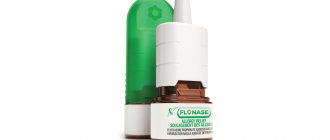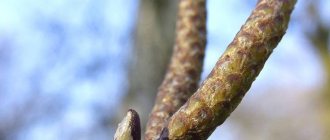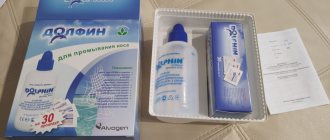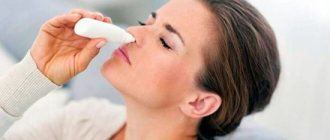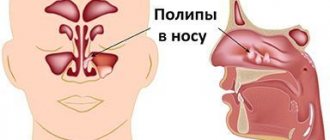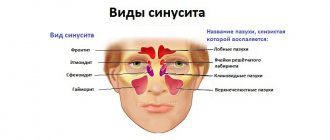The procedure for rinsing the nasal cavity remains an integral part of the complex of measures for the treatment of sinusitis to this day. This method allows you to cleanse the cavity and sinuses of mucus, the excess of which can lead to the formation of pus.
Proper rinsing of the sinuses not only ensures their cleansing, but also restores the ability to independently remove mucous masses, avoiding their accumulation.
The following solutions can be used: pure water, saline solutions, herbal decoctions, aloe juice, as well as special solutions sold in pharmacies (“Aquamaris”, “Dolphin”, “Aqualor”).
Why "cuckoo"?
Well-known among patients of ENT doctors, “cuckoo” in professional slang is called more intricately: rinsing the nose and paranasal sinuses using the fluid displacement method, or the Proetz method. The essence of the short but effective procedure is the creation of alternating pressure in the nasal cavity and paranasal sinuses, which, with the simultaneous administration of fluid, promotes deep rinsing of the sinuses. It is the change in pressure from positive to negative that causes the injected fluid to move into the sinuses and back into the nasal cavity.
The method was developed in the 20th century by the American otorhinolaryngologist Arthur Walter Proetz. But why “cuckoo”? The witty name is explained by the usual recommendation of an ENT doctor to a patient during the procedure: to pronounce the phrase “cuckoo” to reduce the likelihood of fluid getting into the larynx. During the production of this sound, the upper palate closes the nasal cavity away from the oral cavity, which ultimately allows negative pressure to be created in the nasal cavity and sinuses. During the pause between the “k” sounds, the pressure in the nasal cavity is normalized to atmospheric pressure.
What's the benefit?
Swelling of the anastomosis that connects the paranasal sinus with the nasal passage makes it difficult for mucus to flow out, which creates unpleasant symptoms of the disease. Repeated movement of fluid during irrigation flushes out exudate from the nasal passages and sinuses, dilutes purulent discharge, helps reduce swelling and restore drainage function.
The solutions used to rinse the nose contain antiseptics, so the additional benefit of the procedure for sinusitis is its bactericidal and antiviral effect.
There are no serious contraindications. Irrigation is indicated for acute sinusitis and its chronic form.
What are the benefits of rinsing your sinuses?
Rinsing is the process of mechanically releasing the nose. When irrigated with warm sea water, the mucous membrane is restored, breathing is improved, oxygen is supplied, pus is removed, and intoxication is removed in a very important area with the most developed vascular network. That is, the flora is restored in the area with the highest degree of absorption, and, consequently, the infectious load on the body is reduced.
In contrast to the usual blowing of mucus, rinsing achieves complete cleansing of the nose and nasopharynx of all mucus. And this is extremely important in childhood to prevent enlargement of the adenoids and prevent their inflammation.
Relieving swelling helps improve the outflow of pathological contents from the maxillary sinuses. This method of washing allows you to achieve the effect of prolonged irrigation.
Sinusitis - symptoms and treatment
Symptoms of acute sinusitis
Sinusitis begins with a runny nose, like any other respiratory infection.
The appearance of a runny nose means that the sinuses are already inflamed to one degree or another. If a runny nose does not go away within 7-10 days or the symptoms worsen, then you should take it seriously and seek medical help.
A characteristic sign of acute sinusitis is pain in the bridge of the nose and the area of the maxillary sinuses - under the eyes at the level of the cheeks. By evening, the bursting pain becomes more intense. Also, unpleasant pressure in the sinuses increases when tilting or turning the head. If a patient has an inflamed sinus, pain is felt on one side. If the inflammation is bilateral, it hurts on the right and left of the nose. Painful sensations can radiate (give) to the teeth or temporal region.
The second typical symptom of sinusitis is persistent nasal congestion. Sometimes the condition is accompanied by copious mucus or suppuration from the nose. At the initial stage of the disease, the discharge is transparent, then the mucus becomes thick and acquires a green tint, this indicates a change in the phase of inflammation. A change in the nature of the mucus sometimes indicates purulent inflammation. If treatment is not started immediately, the disease may prolong, become more severe, or become more complicated. With severe swelling of the nasal mucosa, there may be no discharge, but the feeling of nasal congestion remains.
Body temperature is usually raised to 38 °C or more. Smells become barely distinguishable, sometimes the sense of smell disappears completely. The patient feels severe weakness and becomes lethargic. It is very difficult to work and do usual things during this period.
Symptoms of chronic sinusitis
In chronic sinusitis, the symptoms are blurred. The disease does not proceed as brightly as in the acute form. During the period of remission there are no complaints. When the disease worsens, the patient’s body temperature rises to subfebrile levels (37.5 ° C), nasal discharge of various types appears (from liquid, clear to purulent) and headaches.
When the patient lies or sleeps, the bursting pain decreases due to the outflow of pus. People with chronic sinusitis periodically complain of coughing attacks at night, which cannot be treated with classic cough medications. The cause of the symptom is mucus from the nasal cavity constantly flowing down the back wall of the pharynx, which irritates the cough receptors [4].
“Cuckoo” technique
Before the procedure, it is necessary to remove swelling from the nasal mucosa. This can be achieved by instilling vasoconstrictor drops into the nose (naphthyzin) or by anemizing the nasal mucosa. To treat adenoiditis, it is enough to drip vasoconstrictor drops into the nose, but for sinusitis (sinusitis, sinusitis, ethmoiditis), we recommend the “anemization” procedure. Anemization of the nasal mucosa is the lubrication of the nasal mucosa with vasoconstrictors, with an emphasis on those areas where the sinuses open. As a result of anemization, the outflow of contents from the paranasal sinuses improves, and the procedure of rinsing the nose using the moving method becomes more effective.
During the procedure, the patient lies on his back, with his head thrown back slightly. It is recommended to breathe evenly through your mouth and, as mentioned earlier, constantly say “ku-ku-ku”.
The doctor slowly infuses a warm antiseptic solution through one nostril and, at the same time, suctions this solution along with mucus and pus from the other nostril with a special vacuum apparatus. The procedure is carried out alternately through one nostril and then through the other. Each nostril requires 50-100 ml of solution, usually 3-6 syringes. The doctor’s task is to create alternating pressure in the nasal cavity when rinsing, while simultaneously introducing liquid into one half and aspirating through the other.
Sometimes an experienced ENT doctor can complicate the procedure by pinching one of the nostrils for 3 seconds and then abruptly releasing the clamp. This is necessary for better penetration of fluid into the sinuses.
By changing the position of the head and the pressure inside the nasal cavity, it is theoretically possible to achieve not only the removal of pus from the sinuses, but also to introduce a drug into the paranasal sinuses. Why "theoretically"? Because this is not always possible. For the “transfer method” to be successful, the openings between the nasal cavity and paranasal sinuses must be open to fluid. It is not always so.
Why is rinsing prescribed?
Nasal rinsing is a procedure that maintains the health of the respiratory system. It should be carried out regularly, especially in the cold season, when the body is susceptible to the development of colds. Also, regular aspiration helps maintain the condition of the channels during the operation of heating devices, which greatly dry out the air in the room.
Washing is necessary for a number of reasons:
- to moisturize the mucous membrane so that it does not become thinner under the influence of dry air masses;
- to relieve swelling, remove mucus;
- to ease breathing during ARVI, rhinitis, sinusitis, sinusitis;
- to relieve symptoms of allergic rhinitis. Aspiration allows you to eliminate pollen and other allergens from the mucous membrane.
Rinsing the nose prevents the development of inflammatory processes. It stimulates the healing of the upper respiratory tract.
Important! Doctors recommend regular washing during the cold season - this is a good prevention of colds.
Indications for sinus lavage using the fluid movement method
“Cuckoo” has long been successfully used to treat most inflammatory diseases of the nose. As for sinusitis itself, we can say that this device is perfectly suited for combating inflammation in the maxillary sinuses.
In addition, the technique is successfully used in the treatment of other diseases of the ENT organs, such as:
- runny nose;
- allergic rhinitis;
- polyps;
- various infections in the nasal passages;
- mild forms of sinusitis: polysinusitis, sinusitis, ethmoiditis, frontal sinusitis, sphenoiditis;
- adenoiditis.
1.What is purulent sinusitis?
Purulent sinusitis
is an inflammatory disease of the maxillary sinuses located in the upper jaw. Most often, sinusitis is complicated by respiratory infections of viral and bacteriological etiology. There are also cases where sinusitis is complicated by allergic rhinitis.
The symptoms of this disease are associated with swelling and congestion of the maxillary sinuses.
: runny nose, coughing and sneezing, pain in the nose and forehead, headaches around the eyes and nose, fatigue and distraction, bursting pain in the jaw. Sinusitis is dangerous due to its complications. Due to stagnation of purulent mucous masses, the process can spread deeper and affect the ocular and intracranial areas. The disease can be unilateral or bilateral.
Is the fluid transfer procedure painful?
The procedure is painless, but unpleasant, especially for young children. In an adult patient, rinsing the sinuses according to Proetz usually does not cause severe discomfort. Therefore, another rinsing option is often used for young children - drip lavage of the nasal cavity. Recommended duration of treatment using the fluid transfer method: from 4 to 10 procedures.
The doctor recommended that you come for 1-2 more procedures, but you think that you are already healthy? It also happens. But, please note: the doctor is responsible for the management of the patient and the result of treatment. Consequently, he remains responsible and has the right to determine the number of procedures per course and the medications that will be used.
It is important for the patient to find “his” doctor whom he will trust and a clinic equipped with the equipment necessary for effective treatment.
Which doctor does the procedure?
At the Kuntsevo Medical Center, rinsing procedures are carried out by professional otolaryngologists. Doctors are highly qualified and attentive to each patient. Thanks to special skills, aspiration occurs painlessly and brings good results.
Sign up for nasal rinsing
To register, choose any method:
- call the clinic +7 (495) 103-99-55,
- order a call back,
- leave a request for an appointment using a convenient form on the website:
Nasal rinsing at home
At home, it is recommended to use a nasal shower and irrigation.
Nasal shower
You can rinse at home using a nasal bulb. First of all, a product is selected - saline solution or a preparation based on sea water.
You need to lean forward about 45 degrees and turn your head to the side. and Pour the contents slowly into the nostril that faces upward. If the patency of the canals is normal, then the solution flows out through the other nostril. If part of the solution has penetrated into the oral cavity, this is not a deviation.
The procedure must be repeated for the second nostril.
Note!
When washing, do not blow your nose too much. Fluid and pathogenic bacteria can enter the middle ear and cause inflammation.
Rules for performing the procedure:
- permissible liquid temperature – 36-37 C;
- for diseases of the nose, the procedure is carried out three times a day, for prevention once a day;
- After washing, you should refrain from going outside.
Contraindicated for:
- severe nasal congestion;
- polyps and other formations;
- deviated septum;
- complications of colds, in particular otitis media;
- regular nosebleeds.
Irrigation
Performed using pharmaceutical drugs. After irrigation, the medicine flows out under gravity. This method is the most gentle, but is not used for purulent discharge and severe congestion.
The patient should take a forward bending position. This is not always convenient for older people. To administer the drug, you must place the cap on the nostril and press on the bottle. The solution should flow out of the other nostril.
What are these funds?
The basis of the vast majority of nasal rinsing solutions is sea water. This component is able to effectively remove mucus from the nose along with the viruses and bacteria found in it, and also cope with swelling due to the salt content in the composition.
Sea salt naturally fights inflammation, soothes irritated mucous membranes, and helps eliminate wounds and microcracks that appear due to frequent nose blowing. In addition, sea water contains useful microelements, such as iodine, which has a bactericidal effect.
Often, rinsing solutions are physiological, that is, the salt concentration in them is 0.9%, which corresponds to the internal environment of the body. Therefore, preparations based on saline solution are absolutely safe and approved for use even for newborns.
